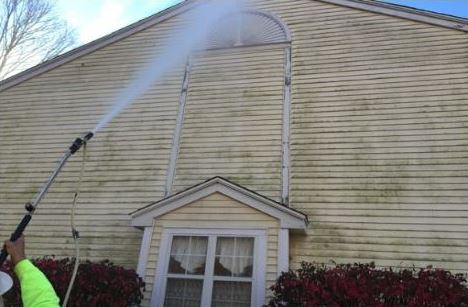
Introduction:
Maintaining the exterior of your home contributes not only to its curb appeal but also to its longevity. Power washing your home siding is an effective DIY method to remove dirt, grime, and mildew, revitalizing its appearance. In this guide, we’ll walk you through the steps of power washing your home siding safely and efficiently.
Choosing the Right Power Washer:
Before you begin, ensure you have the right power washer for the job. Select a pressure washer with a suitable PSI (pounds per square inch) for home use. Higher PSI may be needed for tougher surfaces, but for most home siding, a pressure washer with a range of 1,500 to 2,500 PSI is generally effective without causing damage.
Inspecting and Preparing the Siding:
Start by inspecting your home’s siding for any loose or damaged areas. Repair or replace damaged sections before power washing. Cover electrical outlets and fixtures with plastic to prevent water damage. Remove any obstacles or furniture near the walls that could be affected by water or obstruct the power washer’s path.
Applying a Cleaning Solution:
Many power washers allow for the use of cleaning solutions or detergents. Choose a siding cleaner suitable for your specific siding material. Apply the cleaning solution from the bottom up, allowing it to dwell for a few minutes. This helps break down dirt and grime, making it easier to wash away. Be cautious with plants and grass; cover them with plastic if necessary to protect them from cleaning agents.
Setting Up the Power Washer:
Connect the power washer to a water source and ensure it is functioning correctly. Adjust the nozzle to a wide-angle spray for siding cleaning. Start with a lower pressure setting and gradually increase it as needed. Test the pressure on a small, inconspicuous area to ensure it doesn’t cause damage. Hold the wand at a 45-degree angle to the siding to prevent water from getting behind it.
Power Washing Technique:
Begin power washing from the bottom and work your way up. This prevents streaking and ensures that you’re not driving dirt into areas you’ve already cleaned. Keep a consistent distance from the siding, typically around 6 to 12 inches, adjusting as needed. Use smooth, overlapping strokes to cover the entire surface evenly. Pay extra attention to areas with heavy staining or mildew.
Rinsing and Finishing:
After applying the cleaning solution and power washing, it’s time to rinse the siding thoroughly. Switch to a clean water nozzle or remove the detergent injector to flush out any remaining cleaning solution. Again, work from the bottom up to avoid streaking. Inspect the siding as you rinse to ensure you’ve removed all dirt and detergent residue.
Drying and Inspecting:
Allow the siding to dry completely before inspecting your work. Check for any missed spots, streaks, or areas that may need a second pass. If you encounter stubborn stains, consider spot cleaning with a brush and cleaning solution. Once satisfied, remove any plastic coverings from electrical outlets and fixtures.
Cautions and Considerations:
While power washing is an effective cleaning method, it’s crucial to exercise caution. Avoid using excessive pressure, which can damage siding or force water into wall cavities. Keep a safe distance from windows, doors, and other openings to prevent water intrusion. If you have concerns or encounter issues, consult a professional for advice.
Regular Maintenance Schedule:
Power washing your home siding doesn’t need to be a frequent task. Consider doing it annually or as needed, depending on the climate and the condition of your siding. Regular maintenance helps prevent the buildup of dirt, mildew, and grime, preserving the appearance and integrity of your home’s exterior.
Conclusion – A Revitalized Exterior:
Power washing your home siding is a satisfying DIY project that brings significant visual improvement to your property. By following these steps and precautions, you can achieve a clean and revitalized exterior that enhances your home’s curb appeal.
For detailed guidance on power washing home siding yourself, visit Power Wash Home Siding DIY.










